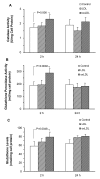Human macrophages limit oxidation products in low density lipoprotein
- PMID: 15745457
- PMCID: PMC555960
- DOI: 10.1186/1476-511X-4-6
Human macrophages limit oxidation products in low density lipoprotein
Abstract
This study tested the hypothesis that human macrophages have the ability to modify oxidation products in LDL and oxidized LDL (oxLDL) via a cellular antioxidant defence system. While many studies have focused on macrophage LDL oxidation in atherosclerosis development, less attention has been given to the cellular antioxidant capacity of these cells. Compared to cell-free controls (6.2 +/- 0.7 nmol/mg LDL), macrophages reduced TBARS to 4.42 +/- 0.4 nmol/mg LDL after 24 h incubation with LDL (P = 0.022). After 2 h incubation with oxLDL, TBARS were 3.69 +/- 0.5 nmol/mg LDL in cell-free media, and 2.48 +/- 0.9 nmol/mg LDL in the presence of macrophages (P = 0.034). A reduction of lipid peroxides in LDL (33.7 +/- 6.6 nmol/mg LDL) was found in the presence of cells after 24 h compared to cell-free incubation (105.0 +/- 14.1 nmol/mg LDL) (P = 0.005). The levels of lipid peroxides in oxLDL were 137.9 +/- 59.9 nmol/mg LDL and in cell-free media 242 +/- 60.0 nmol/mg LDL (P = 0.012). Similar results were obtained for hydrogen peroxide. Reactive oxygen species were detected in LDL, acetylated LDL, and oxLDL by isoluminol-enhanced chemiluminescence (CL). Interestingly, oxLDL alone gives a high CL signal. Macrophages reduced the CL response in oxLDL by 45% (P = 0.0016). The increased levels of glutathione in oxLDL-treated macrophages were accompanied by enhanced catalase and glutathione peroxidase activities. Our results suggest that macrophages respond to oxidative stress by endogenous antioxidant activity, which is sufficient to decrease reactive oxygen species both in LDL and oxLDL. This may suggest that the antioxidant activity is insufficient during atherosclerosis development. Thus, macrophages may play a dual role in atherogenesis, i.e. both by promoting and limiting LDL-oxidation.
Figures






Similar articles
-
Oxidized low-density lipoprotein elicits an intracellular calcium rise and increases the binding activity of the transcription factor NFAT.Free Radic Biol Med. 2005 Feb 15;38(4):472-80. doi: 10.1016/j.freeradbiomed.2004.10.028. Free Radic Biol Med. 2005. PMID: 15649649
-
Oxidized low-density lipoprotein depletes PKCalpha and attenuates reactive oxygen species formation in monocytes/macrophages.Cardiovasc Res. 2006 Aug 1;71(3):574-85. doi: 10.1016/j.cardiores.2006.05.023. Epub 2006 May 27. Cardiovasc Res. 2006. PMID: 16843450
-
Induction of glutathione synthesis in macrophages by oxidized low-density lipoproteins is mediated by consensus antioxidant response elements.Circ Res. 2003 Mar 7;92(4):386-93. doi: 10.1161/01.RES.0000059561.65545.16. Epub 2003 Feb 6. Circ Res. 2003. PMID: 12600891
-
Antibodies to oxidized low density lipoprotein: epidemiological studies and potential clinical applications in cardiovascular disease.Minerva Cardioangiol. 2007 Dec;55(6):821-37. Minerva Cardioangiol. 2007. PMID: 18091649 Review.
-
Pomegranate juice flavonoids inhibit low-density lipoprotein oxidation and cardiovascular diseases: studies in atherosclerotic mice and in humans.Drugs Exp Clin Res. 2002;28(2-3):49-62. Drugs Exp Clin Res. 2002. PMID: 12224378 Review.
Cited by
-
Macrophages actively accumulate malonyldialdehyde-modified but not enzymatically oxidized low density lipoprotein.Mol Cell Biochem. 2012 Jun;365(1-2):93-8. doi: 10.1007/s11010-012-1247-5. Epub 2012 Feb 4. Mol Cell Biochem. 2012. PMID: 22307746
-
Relationship of oxidized low density lipoprotein with lipid profile and oxidative stress markers in healthy young adults: a translational study.Lipids Health Dis. 2011 Apr 19;10:61. doi: 10.1186/1476-511X-10-61. Lipids Health Dis. 2011. PMID: 21504598 Free PMC article.
-
The liver-selective thyromimetic T-0681 influences reverse cholesterol transport and atherosclerosis development in mice.PLoS One. 2010 Jan 15;5(1):e8722. doi: 10.1371/journal.pone.0008722. PLoS One. 2010. PMID: 20090943 Free PMC article.
-
Vimentin deficiency in macrophages induces increased oxidative stress and vascular inflammation but attenuates atherosclerosis in mice.Sci Rep. 2018 Nov 19;8(1):16973. doi: 10.1038/s41598-018-34659-2. Sci Rep. 2018. PMID: 30451917 Free PMC article.
-
Antioxidant and anti-inflammatory effects of Marrubium alysson extracts in high cholesterol-fed rabbits.Saudi Pharm J. 2014 Nov;22(5):472-82. doi: 10.1016/j.jsps.2013.12.004. Epub 2013 Dec 21. Saudi Pharm J. 2014. PMID: 25473336 Free PMC article.
References
-
- van Reyk DM, Jessup W, Dean RT. Prooxidant and antioxidant activities of macrophages in metal-mediated LDL oxidation: the importance of metal sequestration. Arterioscler Thromb Vasc Biol. 1999;19:1119–1124. - PubMed
Publication types
MeSH terms
Substances
LinkOut - more resources
Full Text Sources

